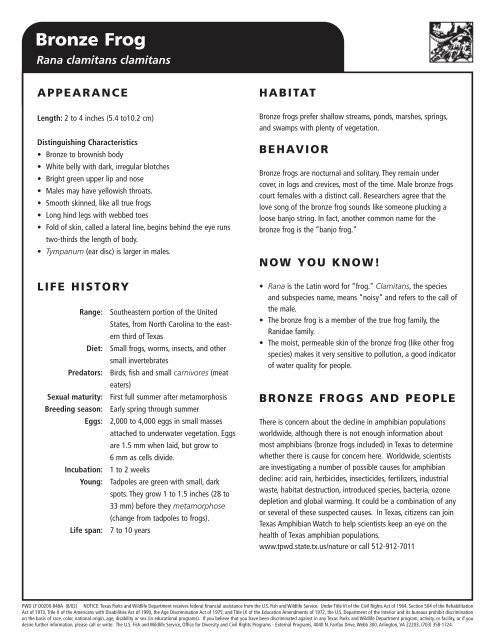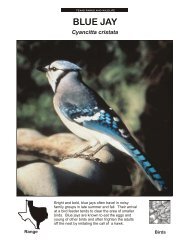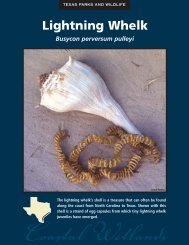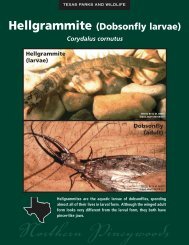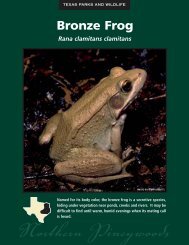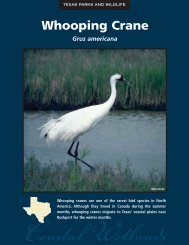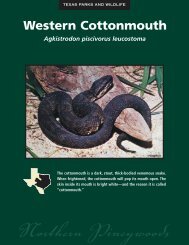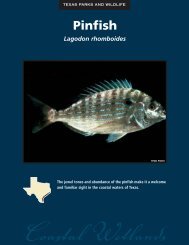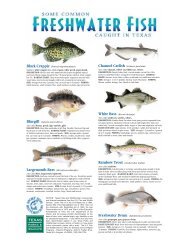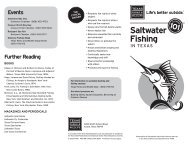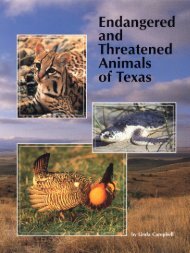You also want an ePaper? Increase the reach of your titles
YUMPU automatically turns print PDFs into web optimized ePapers that Google loves.
<strong>Bronze</strong> <strong>Frog</strong>Rana clamitans clamitansAPPEARANCELength: 2 to 4 inches (5.4 to10.2 cm)Distinguishing Characteristics• <strong>Bronze</strong> to brownish body• White belly with dark, irregular blotches• Bright green upper lip and nose• Males may have yellowish throats.• Smooth skinned, like all true frogs• Long hind legs with webbed toes• Fold <strong>of</strong> skin, called a lateral line, begins behind the eye runstwo-thirds the length <strong>of</strong> body.• Tympanum (ear disc) is larger in males.LIFE HISTORYRange: Southeastern portion <strong>of</strong> the United<strong>State</strong>s, from North Carolina to the easternthird <strong>of</strong> TexasDiet: Small frogs, worms, insects, and othersmall invertebratesPredators: Birds, fish and small carnivores (meateaters)Sexual maturity: First full summer after metamorphosisBreeding season: Early spring through summerEggs: 2,000 to 4,000 eggs in small massesattached to underwater vegetation. Eggsare 1.5 mm when laid, but grow to6 mm as cells divide.Incubation: 1 to 2 weeksYoung: Tadpoles are green with small, darkspots. <strong>The</strong>y grow 1 to 1.5 inches (28 to33 mm) before they metamorphose(change from tadpoles to frogs).Life span: 7 to 10 yearsHABITAT<strong>Bronze</strong> frogs prefer shallow streams, ponds, marshes, springs,and swamps with plenty <strong>of</strong> vegetation.BEHAVIOR<strong>Bronze</strong> frogs are nocturnal and solitary. <strong>The</strong>y remain undercover, in logs and crevices, most <strong>of</strong> the time. Male bronze frogscourt females with a distinct call. Researchers agree that thelove song <strong>of</strong> the bronze frog sounds like someone plucking aloose banjo string. In fact, another common name for thebronze frog is the “banjo frog.”NOW YOU KNOW!• Rana is the Latin word for “frog.” Clamitans, the speciesand subspecies name, means “noisy” and refers to the call <strong>of</strong>the male.• <strong>The</strong> bronze frog is a member <strong>of</strong> the true frog family, theRanidae family.• <strong>The</strong> moist, permeable skin <strong>of</strong> the bronze frog (like other frogspecies) makes it very sensitive to pollution, a good indicator<strong>of</strong> water quality for people.BRONZE FROGS AND PEOPLE<strong>The</strong>re is concern about the decline in amphibian populationsworldwide, although there is not enough information aboutmost amphibians (bronze frogs included) in Texas to determinewhether there is cause for concern here. Worldwide, scientistsare investigating a number <strong>of</strong> possible causes for amphibiandecline: acid rain, herbicides, insecticides, fertilizers, industrialwaste, habitat destruction, introduced species, bacteria, ozonedepletion and global warming. It could be a combination <strong>of</strong> anyor several <strong>of</strong> these suspected causes. In Texas, citizens can joinTexas Amphibian Watch to help scientists keep an eye on thehealth <strong>of</strong> Texas amphibian populations.www.tpwd.state.tx.us/nature or call 512-912-7011PWD LF D0200-848A (8/02) NOTICE: Texas Parks and Wildlife Department receives federal financial assistance from the U.S. Fish and Wildlife Service. Under Title VI <strong>of</strong> the Civil Rights Act <strong>of</strong> 1964, Section 504 <strong>of</strong> the RehabilitationAct <strong>of</strong> 1973, Title II <strong>of</strong> the Americans with Disabilities Act <strong>of</strong> 1990, the Age Discrimination Act <strong>of</strong> 1975, and Title IX <strong>of</strong> the Education Amendments <strong>of</strong> 1972, the U.S. Department <strong>of</strong> the Interior and its bureaus prohibit discriminationon the basis <strong>of</strong> race, color, national origin, age, disability or sex (in educational programs). If you believe that you have been discriminated against in any Texas Parks and Wildlife Department program, activity, or facility, or if youdesire further information, please call or write: <strong>The</strong> U.S. Fish and Wildlife Service, Office for Diversity and Civil Rights Programs - External Programs, 4040 N. Fairfax Drive, Webb 300, Arlington, VA 22203, (703) 358-1724.


